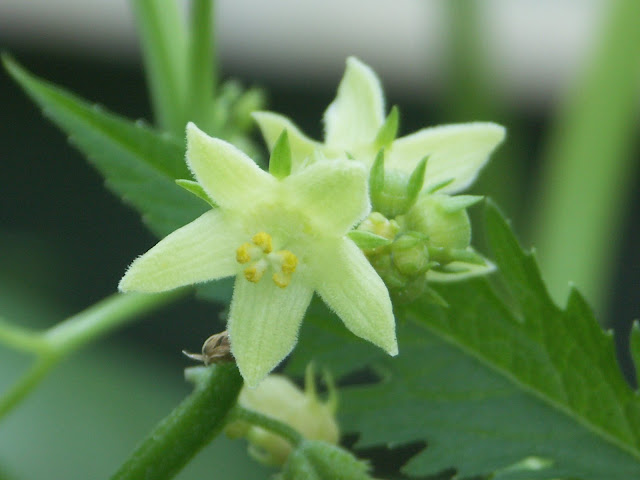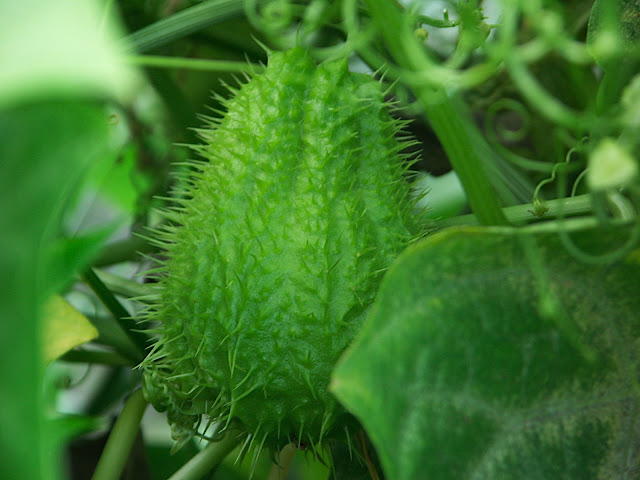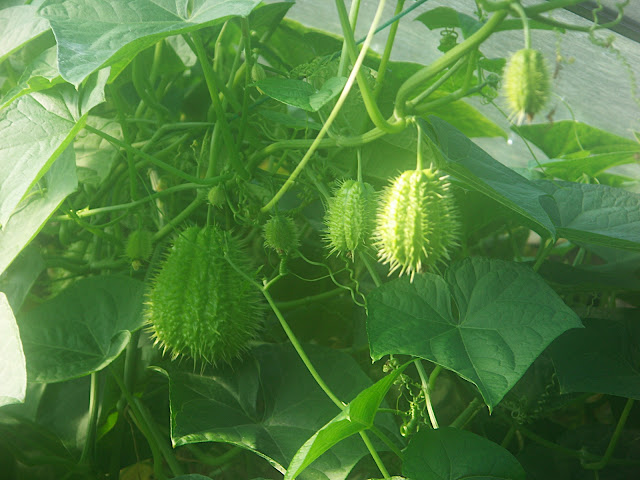|
|
Post by hiven on Dec 30, 2008 11:16:02 GMT -5
I bought 3 fruits some 15 days ago just to see if I may/could grow them in NL. I noticed 2 of the fruits started to grow (one with root and the other with mini shoot). Will set each of them on top of a 3lt pot (half buried in compost) tomorrow and place them by the sunniest window sills we got. Will sit back ,wait and watch  . Have you got any experience with growing them, shed me some light please, thanks  . |
|
|
|
Post by orflo on Dec 30, 2008 13:54:26 GMT -5
Chayote is one of my 'never-worked' vegetables...  I try them every year, but I get nothing... First of all, you need to know there are quite a lot of chayote varieties about, although the only one seen here is the common, unspiny light'green one. There are indeed very spiny (soft spines) varieties, as well as darker and lighter coloured... But more important is even the fact that there are varieties that produce earlier compared to others. And getting one of these is part of the solution for growing this out. My friend Jean-Luc in the neighbourhood of Luik had such a variety for a couple of years, but he probably lost it this year (I'll ask him when he returns from his winter journey), and he always had a smalll harvest. There's someone in Normandy (France) who has a very early variety, I'm trying to trace him, but , up to now , I didn't find his name or address... Chayote needs warmth, warmth and warmth, and some moisture. So, place it in the greenhouse, but beware, it can overtake the greenhouse, I've seen them up to 8 metres long, in the warm 2006 summer... I hope you can overwinter your seedlings, it's very early to have them (don't give them too much water, they could rot away when temperatures aren't really over 25°C. There are some production areas in the South of France, right where the kiwis grow as well. The chayotes are grown over there on trellises, and do become big , but not as big as the pictures I've seen from the Mexican grown chayotes, who are on a frost-free spot and perennial. |
|
|
|
Post by hiven on Dec 31, 2008 7:42:45 GMT -5
Orflo, oh this chayota sounds alike my other white elephant project  ... I bought the white peel one (smooth skin) which perhaps came from Thailand. I can however get the Chayota from Colombia (light green and smooth skin) but don't know if that makes any different in the earliness of maturity. I did have several spiny chayotas (bought from Madeira island-Portugal) last year but because we didn't have any space, I cooked and eat them all. I will try to grow them anyway and see what happen but won't hold my breath for them, if there are no fruit, I can at least harvest the young shoots, it said to be very tasty. Will report back... thanks for the info! |
|
|
|
Post by stevil on Dec 31, 2008 8:53:14 GMT -5
|
|
|
|
Post by hiven on Dec 31, 2008 10:11:51 GMT -5
Thanks for the picture Stevil, I can see several fruit hanging on it  . A friend of mine told me, her old neighbour grow 2 chayota plants (in NL), and they were so fruitfull from late summer onwards till the frost kill it back, perhaps I should buy some fruits produced from the plant as they seems to be adapted to NL climate (or simply early maturing type ?). Orflo, perhaps, Stevil has answered your search  . |
|
|
|
Post by bunkie on Dec 31, 2008 10:13:40 GMT -5
wow stevil! that's amazing! |
|
|
|
Post by orflo on Dec 31, 2008 10:20:41 GMT -5
Nono, Sébastien is a friend of mine, he's in the middle of France, and in fact he is the person who told me about someone in Normandy, but he didn't have a name or adress... Try to order a 2006 or 2003 summer, it could work then..., meanwhile, there should be pictures on Jean-Lucs site: www.lepotagergourmand.be , just click on the letter c in the alfabet and scroll to the middle of the page, and also take a look at the rest of the site, it's good... |
|
|
|
Post by hiven on Jan 1, 2009 9:57:36 GMT -5
Orflo, when is the best time to let them sprout ? and do you grow yours in a green house ? I presume mine sprouted way too early  , but will try to save it anyway (plan to use 10 lt pots for them). I should have a green house by February or March next year, will reserve some space for them. |
|
|
|
Post by raymondo on Jan 9, 2009 5:33:29 GMT -5
When I was growing up, everyone had choko vines in their gardens (choko is what we call chayote). They would be used as a cooked vegetable on their own just steamed then smothered in butter and black pepper but their main use was as a bulking agent. If you didn't have enough apples for an apple pie, you just added chokoes to make up the bulk. Same would apply to jams, pickles, chutneys and so forth. The good old choko would step in to fill another's shoes, as it were. They seem to have the ability to take on the flavour of whatever they're cooked with! I can't grow them where I live now becasue the season is too short.
To plant one, just place the fruit on top of the soil, on an angle, with only the stem end in contact with the soil. No need to bury it. In fact, if it's too cold or too humid it will rot. If you keep the fruit in a warm place, you will see a shoot or roots forming so you will know which part to put in contact with the soil.
|
|
|
|
Post by hiven on Jan 11, 2009 12:50:15 GMT -5
Thanks for the extra info Raymondo. I ate it for many times and loved it very much. The young fruit taste very yummy. We just got back from Canary island (La Palma) and I actually found another 3 types there (2 spiny types and a smooth dark green type).
|
|
|
|
Post by orflo on Sept 21, 2009 1:16:38 GMT -5
I finally did find one suitable for my climate, I received it from an Italian lady, and it grows like hell in my greenhouse. The lady told me she usually had over 100 fruits on three vines, that's a lot!!! Up to now, some 25 fruits are forming over here, on two vines. The young shoots are also very enjoyable, stir-fried they make a great additive to all sorts of things. The female flowers need to be hand-pollinated over here, male flowers aren't really very visible nor abundant, insects don't seem to find them. The development of the fruits is very quick, they grow some 10 cms (4 inches) each week. As you can see this variety is spiny, I hope to cross it in one day with a non-spiny variety (although the spines are quit soft and perfectly edible when prepared). female flower:  male flower:  fruit(some 6-7 inches long/15-18 cms)  |
|
|
|
Post by hiven on Sept 26, 2009 14:55:55 GMT -5
Frank, you are so lucky with them, congratulations. Ours (from Canary island) just made some tiny female flowers, don't think they will made it to mature fruit as it is getting so cool now...
We are soooo happy for you !!
|
|
|
|
Post by orflo on Sept 28, 2009 14:27:57 GMT -5
It's not the brightest picture in the world, but it gives an indication:  |
|
|
|
Post by hiven on Oct 9, 2009 16:16:54 GMT -5
Frank, I think we are grand parents ! Your boy and my girl were married... ermmm I mean the female flower which were hand pollinated with your chayote's pollen kind of growing to around 1cm now... I hope we get the cross, if so, I will mail our grand child to you  . |
|
|
|
Post by hiven on Oct 9, 2009 16:22:13 GMT -5
Oh wait a minute, you said they grow up to 10 cm/week, mine grow very slow, could it be because not really pollinated ? I will keep noting down the progress...
|
|